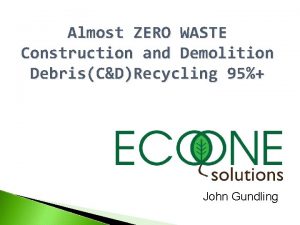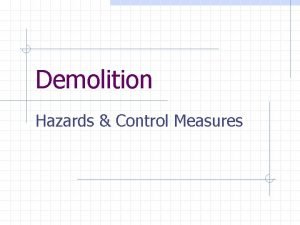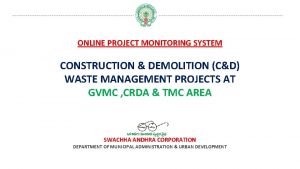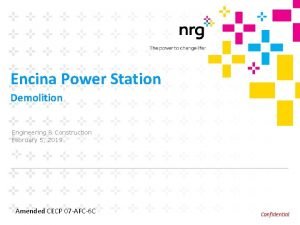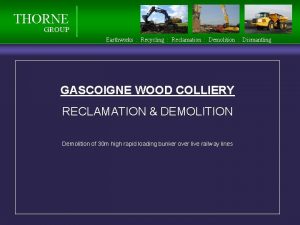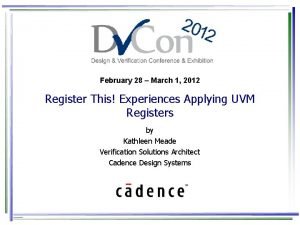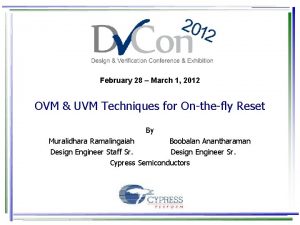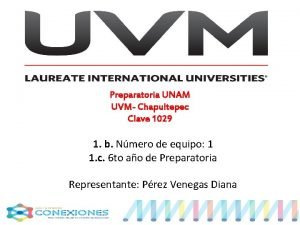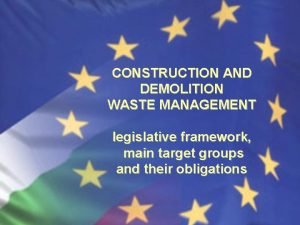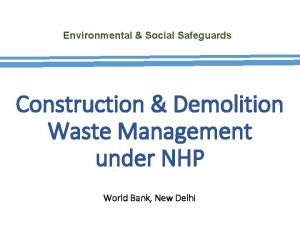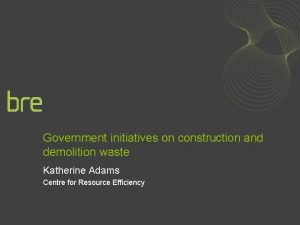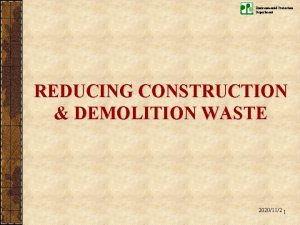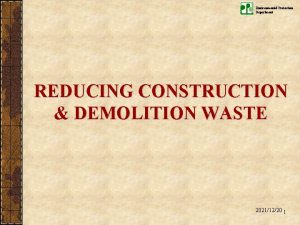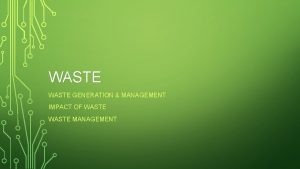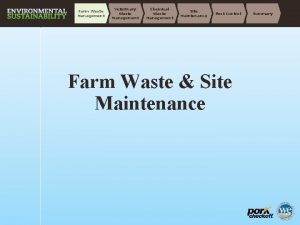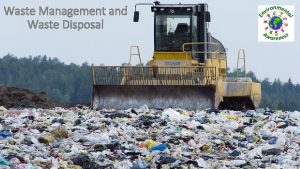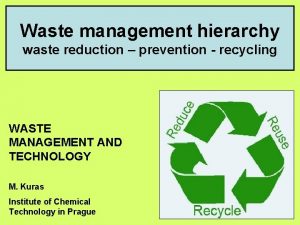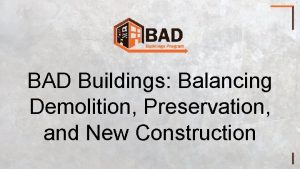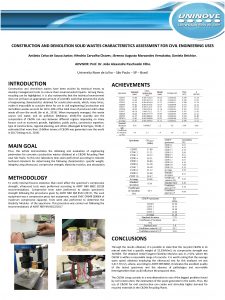Construction and Demolition Waste Management at UVM Construction

















- Slides: 17

Construction and Demolition Waste Management at UVM

Construction and Demolition Waste Opportunities • Construction and demolition waste is 20 -40% of the waste stream going to landfills nationally • C+D waste is being generated at UVM everyday; we estimate there are nearly one hundred active projects on campus on any given day.

Environmental Impacts • Landfill leaks • Methane gas generation • Energy lost by not recycling / re-claiming materials • Transportation: greenhouse gas emissions

Definition of C&D Waste “Waste material that is produced in the process of construction, renovation, or demolition of structures. Structures include buildings of all types (both residential and non-residential) as well as roads and bridges. Components of C&D debris typically include concrete, asphalt, wood, metals, gypsum wallboard and roofing”. -EPA

Key Terms • Construction waste- waste generated while constructing a new building or structure • Demolition waste- waste generated while taking down an existing building or structure • Deconstruction- the taking apart of an existing building so that materials can be re-used elsewhere

Typical C&D Wastes • Asphalt, Asphalt Shingles • Carpet padding • Clean wood/pallets • Concrete • Corrugated cardboard

Typical C&D Wastes • Gypsum (drywall) • Land clearing debris • Scrap metal • Salvage • Other…

Requirements at UVM • Major projects: new buildings, major renovations • Minor projects: short term or partial building projects • Ongoing renovations: Physical Plant routine maintenance and renovation

Requirements at UVM • The waste management plan will be based on LEED® guidelines for C+D waste management • The plan must divert at least 50% of waste generated from the project • Workers must view training presentation as part of job site orientation

C&D EMS • Focuses on continuous program improvement by organizing activities into four stages: – – Plan Do Check Act • Program documentation is to maintain program improvements over time • This approach is based on organizational quality improvement practices

C&D EMS • Plan: vendor identification, development of job specifications • Do: walkthrough checklist, collection of disposal tickets • Check: entering of disposal data into the system, meeting of LEED goals • Act: evaluation of program by project managers, analysis of financial impacts

C&D EMS • Plan: tri-annual review of vendor options and specifications • Do: implement the project tracking system for all major projects and move the size of the projects covered smaller and smaller • Check: assure C&D waste LEED points are achived for every project (50% recycled for 1 point; 75% for 2 points) plus innovation point • Act: financial break even compared to landfilling the entire job

LEED Requirements • The Leadership in Energy and Environmental Design (LEED®) Green Building Rating System is the nationally accepted benchmark for the design, construction and operation of high performance green buildings. • It gives building owners and operators the tools they need to have an immediate and measurable impact on their buildings’ performance, by promoting a whole-building approach to sustainability.

LEED Requirements • LEED certification is required for large projects at UVM – According to the 2007 “Environmental Design in New and Renovated Buildings” Policy, UVM projects must achieve 33/69 points to achieve the required ‘Silver’ rating. • In the LEED-NC 2. 2 Rating system, there are 2 points available for Construction and Demolition waste diverted from the landfill: – 1 point if 50% of waste is diverted – 2 points if 75% of waste is diverted • The UVM tracking tool collects and reports the information that must be submitted to receive these points.

LEED Criteria • MR Credit 2. 1: Construction Waste Management: Divert 50% From Disposal: 1 Point – Recycle and/or salvage at least 50% of non-hazardous construction and demolition debris. – Develop and implement a construction waste management plan that, at a minimum, identifies the materials to be diverted from disposal and whether the materials will be sorted on-site or co- mingled. Excavated soil and landclearing debris do not contribute to this credit. Calculations can be done by weight or volume, but must be consistent throughout. • MR Credit 2. 2: Divert 75% From Disposal: – 1 Point in addition to MR Credit 2. 1 – Recycle and/or salvage an additional 25% beyond MR Credit 2. 1 • Additional points for using salvaged and/or recycled content building materials

Demolition/Deconstruction and New Construction Required Elements • Collection containers must be on site and labeled clearly before demolition can begin • Waste must be separated into appropriate categories • Labeled bins will remain on site for waste generated in new construction • All waste shipped off-site must be tracked in C&D database

Online Tracking Tool Website • The Green Building Coordinator Homepage: – http: //www. uvm. edu/~gbc/ • The Online Tracking Tool Data Entry Page: – http: //www. uvm. edu/~gbc/cdw/? Page=projects. php
 Demolition zero waste
Demolition zero waste Demolition hazards and controls
Demolition hazards and controls Vancleave upper elementary
Vancleave upper elementary Demolition monitoring solutions
Demolition monitoring solutions Unrollm
Unrollm Encina power plant demolition
Encina power plant demolition Earthworks recycling
Earthworks recycling Murtagh demolition
Murtagh demolition Uvm dorm rooms
Uvm dorm rooms Lbo analysis
Lbo analysis Uvm citi training
Uvm citi training Uvm_reg class
Uvm_reg class Uvm phases
Uvm phases Uvm comis
Uvm comis Prepa uvm chapultepec
Prepa uvm chapultepec Uvm fælles mål madkundskab
Uvm fælles mål madkundskab Uvm student research conference
Uvm student research conference Jens hilke
Jens hilke
